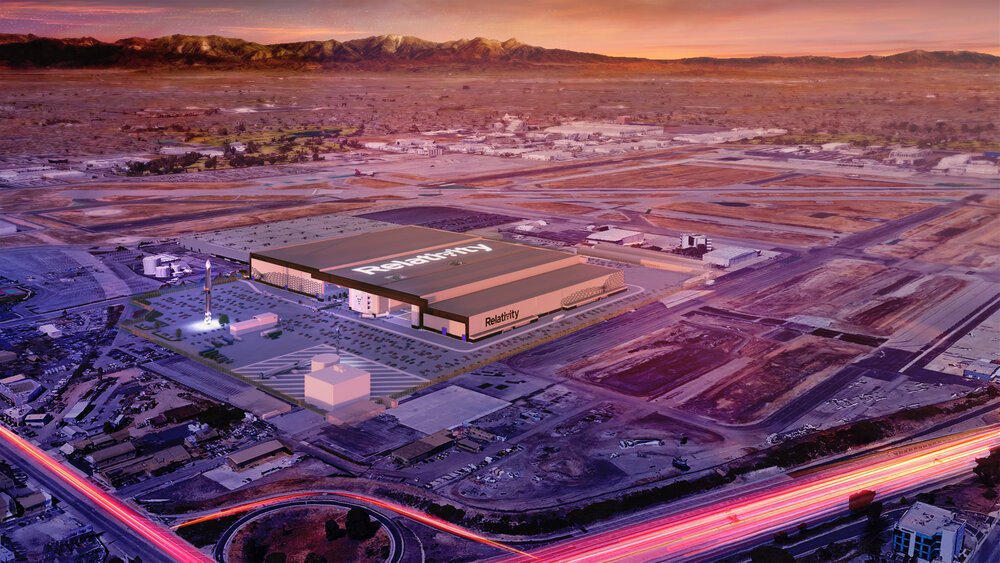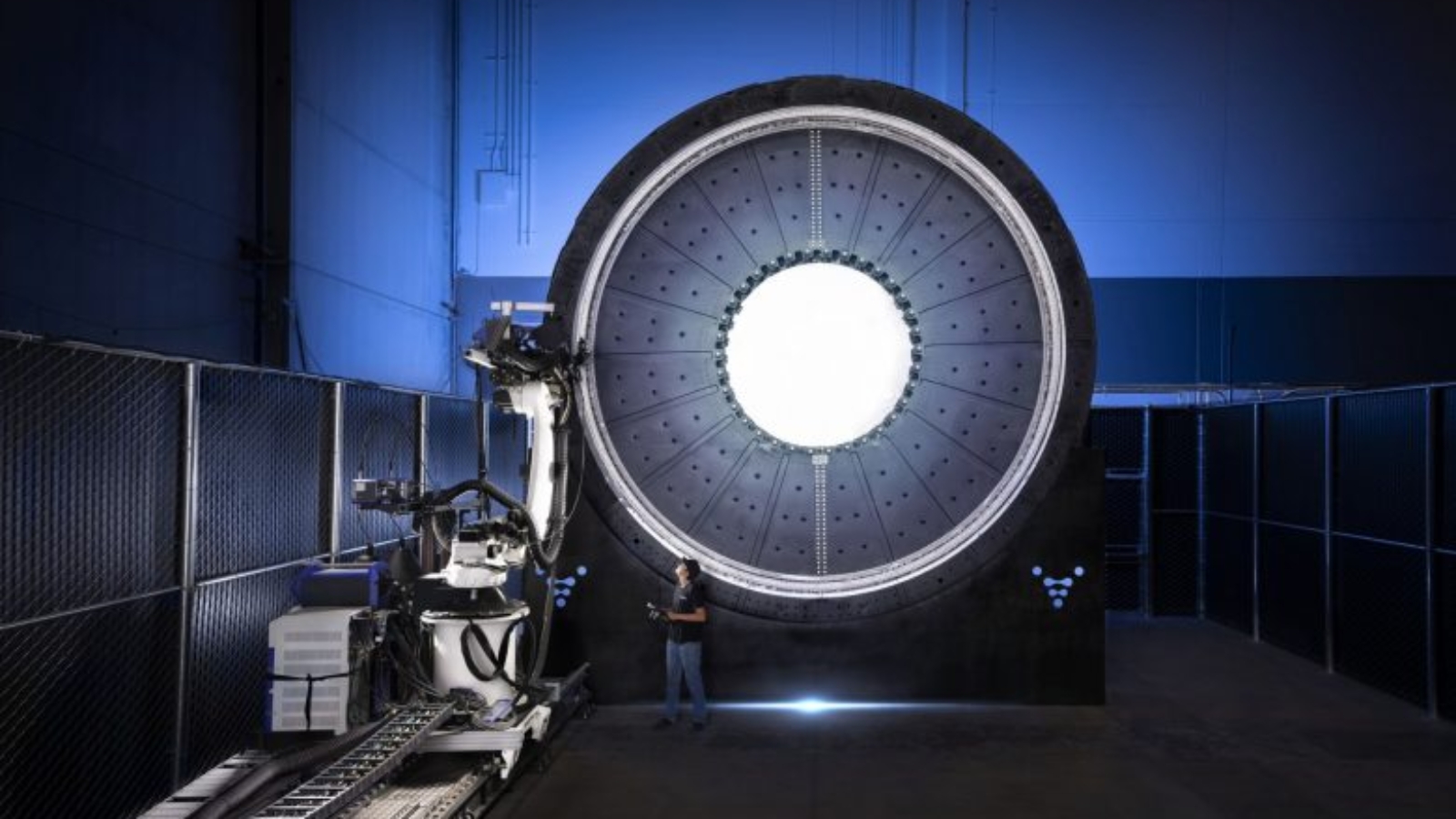Relativity Space, the first company to 3D print rockets and build the largest metal 3D printers in the world, unveiled the latest iteration of its first-of-its-kind proprietary manufacturing platform, Stargate 4th Generation metal 3D printers. These printers will underpin both the development and rate production of Terran R, Relativity’s fully reusable, 3D printed rocket that will be capable of launching 20,000 kg to low Earth orbit (LEO).
The newest Stargate printer technology defies traditional printing constraints by moving horizontally as it feeds multiple wires into a single print head to print orbital rockets. Relativity is developing customized software and machine learning techniques to allow these printers to print more complex and significantly larger metal products, with improved print speed and reliability. Stargate 4th Generation printers also radically simplify manufacturing supply chains, as they are capable of printing a rocket with 100x fewer parts in a matter of months.
“Large-scale products that are designed to fly will inevitably be 3D printed,” said Tim Ellis, cofounder and CEO of Relativity Space. “The lighter a product is, the better it performs, and when 3D printing that product, it’s also faster and more cost-effective to produce with each successive improvement. The compounding rate of progress is high, and we are still in the early days of what printing can achieve. We see 3D printing as an automation technology that has the power to change the pace of innovation in manufacturing, which is why we’ve invested in building our own proprietary tech stack from day one. Stargate printers are designed to unlock rapid iteration, which opens up opportunities for innovation in large-scale manufacturing products. What would take traditional aerospace and space manufacturers years to develop and build, will be reduced down to months due to a highly adaptable, scalable, and automated process, made possible through software-driven manufacturing.”

With faster iteration cycles, Stargate printers are capable of accelerating progress and innovation within the aerospace industry. Most immediately, Stargate 4th Generation printers will serve as the primary manufacturing infrastructure for Terran R production. Longer-term, Stargate 4th Generation printers offer tremendous value-generating potential for other end-product use cases within the $1T+ aerospace, aviation, energy, and defense industries as the core of a new tech stack for aerospace products. To date, Relativity has secured five customers across $1.2B+ in customer contracts for Terran R, including a multi-launch agreement with OneWeb and a commercial mission to Mars with Impulse Space.
The Stargate 4th Generation printer technology promises significant improvements in print speed: 1st, 2nd, and 3rd Generation Stargate printers already operate at print speeds well beyond industry standards. Stargate 4th Generation printers offer 7x faster than earlier generation Stargate printers and achieve up to 12x faster printing over Relativity’s already industry-leading performance.
In addition, the use of a horizontal print orientation increases print size capacity. Stargate 4thgeneration printers remove ceiling height constraints that impact vertical 3D printers. Through horizontal printing, these printers are capable of producing objects up to 120 feet long and 24 feet wide, resulting in an increased volume capacity of 55x its 3rd generation predecessor.
Manufacturing on Demand
Reduced print start time and cost is supported by an integrated approach to build setup and print plate preparation. Reduced entropy, for more consistent, reliable manufacturing can be realized through a configuration that centralizes work centers around Stargate’s robotic automation platform. Improved print quality and work center efficiency is achieved through powerful perception technology for in-process monitoring, which fuses together computer vision, advanced sensors and real-time telemetry.

This results in radical part count reduction, as well as rapid design iterations, as Stargate printers are not beholden to long-lead, high capital expenditure fixed tooling. Lighter, more cost-effective aerospace product production through rapid iteration is generated by leveraging Stargate printers and material science advancements developed in Relativity’s in-house metallurgical laboratory.
Relativity also has proprietary, high-performance next-generation materials which will be used for products printed with Stargate 4th Generation printers. Most immediately, Terran R will be the first product in a series of products to benefit from use of lighter materials and a faster production time, creating significant cost reductions for customers downstream.
“Iteration empowers innovation not only in our rocket design, but also in our own Stargate printers,” said Scott Van Vliet, SVP of Software Engineering. “In its short history, Relativity has made great strides in evolving its core 3D printing technology, but Stargate 4th Generation printers are our most innovative leap yet. We’re fundamentally changing the way our factories are designed and operating, and by flipping the script and going horizontal, we’re radically increasing our capacity for scale. Being a software-driven manufacturing company allows us to achieve unique product features, such as integrated pad-ups and domes, with radical flexibility.”
The majority of Terran R components will be printed inside Relativity’s new 1 million+ square foot headquarters in Long Beach, named The Wormhole. Aeon R engines, for Terran R, will continue to be produced at the company’s other Long Beach factory, The Portal. The Wormhole, a former Boeing C-17 manufacturing plant, was secured by Relativity to be its new headquarters in 2021. Currently 33% operational, the factory has several Stargate 4th Generation printers online with more than a dozen printers planned to be producing Terran R components in the coming months. At full capacity forecasted run rate, each Stargate 4th Generation printer is capable of producing 4 Terran R rockets per year. The remainder of The Wormhole will continue to be built out in phases, bringing more printers online and moving more teams into the company’s headquarters as production for Terran R scales.
You might also like:
The RAF installs Wayland Additive’s Calibur3 metal 3D printer: Introduced by No 71 (IR) Squadron, additive manufacturing is a new capability for the RAF, and will ultimately provide a breakthrough in the RAF’s ability to design and produce its own aircraft spares, on demand.
* This article is reprinted from 3D Printing Media Network. If you are involved in infringement, please contact us to delete it.
Author: 3D Printing Media Network


Leave A Comment